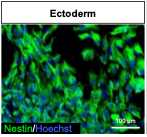CAR-TIM3 iPSCs
The cell line is not validated yet.
MUSIi013-A-2
General
Cell Line |
|
| hPSCreg name | MUSIi013-A-2 |
| Cite as: | MUSIi013-A-2 |
| Alternative name(s) |
CAR-TIM3 iPSCs
|
| Cell line type | Human induced pluripotent stem cell (hiPSC) |
| Similar lines |
MUSIi013-A (CBNK-iPSC) |
| Last update | 18th October 2023 |
| User feedback | |
Provider |
|
| Generator | Faculty of Medicine Siriraj Hospital (MUSI) |
External Databases |
|
| BioSamples | SAMEA114502805 |
General Information |
|
| Publications | |
| * Is the cell line readily obtainable for third parties? |
No |
| Subclone of | |
Donor Information
General Donor Information |
|
| Sex | female |
Phenotype and Disease related information (Donor) |
|
| Diseases | No disease was diagnosed.
|
External Databases (Donor) |
|
| BioSamples | SAMEA114502804 |
Ethics
Also have a look at the ethics information for the parental line
MUSIi013-A
.
| Is there an MTA available for the cell line? | No |
| For generation of the cell line, who was the supplier of any recombined DNA vectors or commercial kits used? | |
| Are you aware of any constraints on the use or distribution of the cell line from the owner or any parties identified in the query above? | No |
hIPSC Derivation
General |
|
|
The source cell information can be found in the parental cell line
MUSIi013-A.
|
|
Reprogramming method |
|
| Vector type | Non-integrating |
| Vector | Episomal |
Vector free reprogramming |
|
Other |
|
| Derived under xeno-free conditions |
Unknown |
| Derived under GMP? |
Unknown |
| Available as clinical grade? |
Unknown |
Culture Conditions
| Medium |
Other medium:
Base medium: NutriStem
Main protein source: Serum concentration: % |
Characterisation
Analysis of Undifferentiated Cells
1) Use Flow cytometric analysis of surface expression of SSEA-3, SSEA-4, TRA-1-60 and TRA-1-81
2) Use immunofluorescent staining to determine nuclear expression of OCT4, NANOG and SOX2 proteins
3) Use RT-qPCR analysis to quantify the expression of OCT4, NANOG and SOX2 mRNA compared to H1-ES cells and the parental MUSIi-013-A line
Method documentation
TIM3-pluripotent.png
IF staining, FACS analysis and RT-qPCR analysis of pluripotence marker
Differentiation Potency
In vitro spontaneous differentiation
Genotyping
Karyotyping (Cell Line) |
|
| Has the cell line karyotype been analysed? |
Yes
46,XX
Karyotyping method:
G-Banding
|
Other Genotyping (Cell Line) |
|
Genetic Modification
| Genetic modifications not related to a disease |
|





Login to share your feedback, experiences or results with the research community.